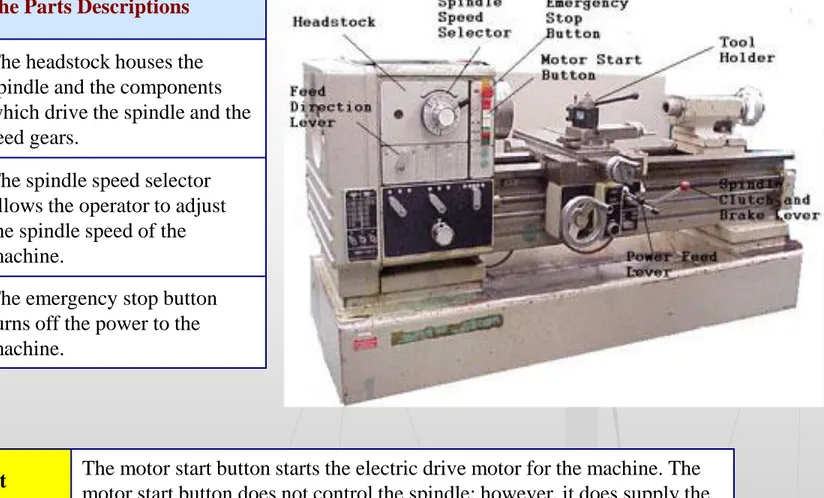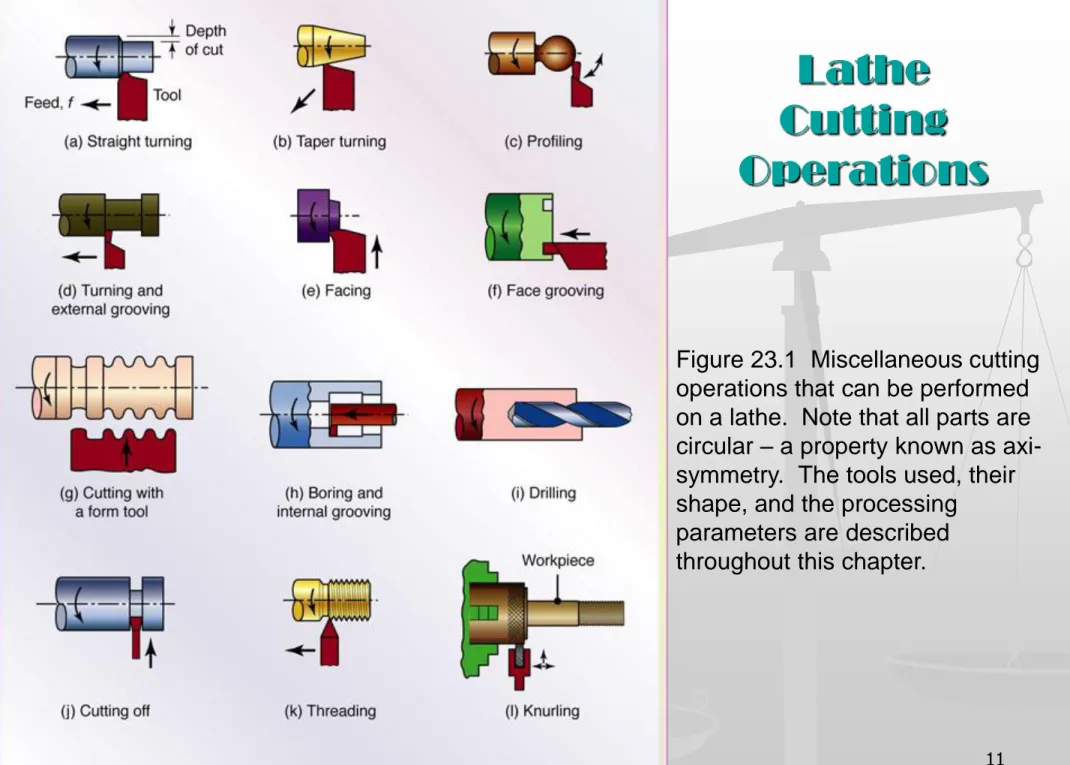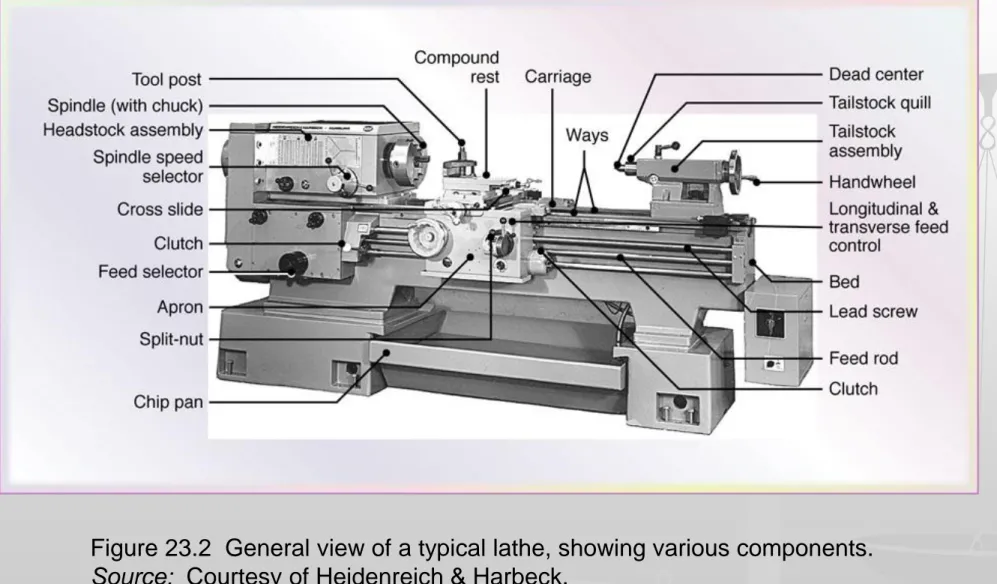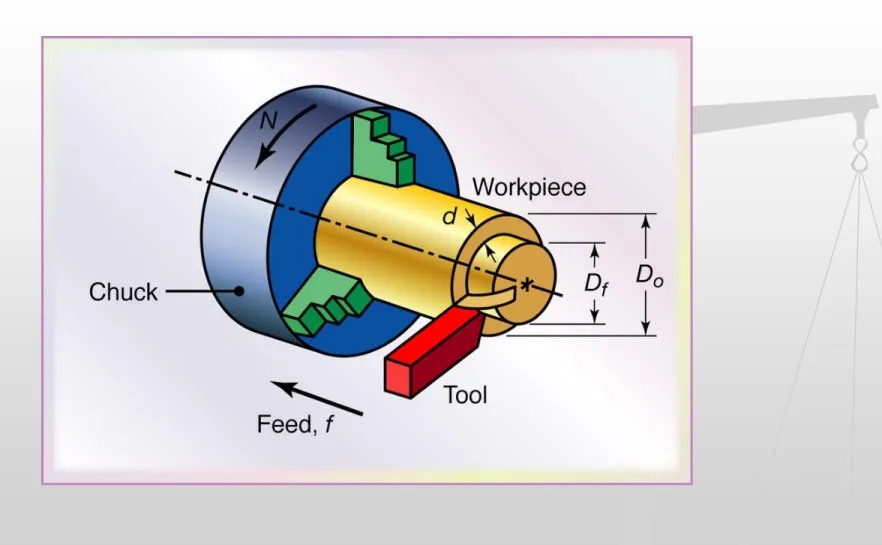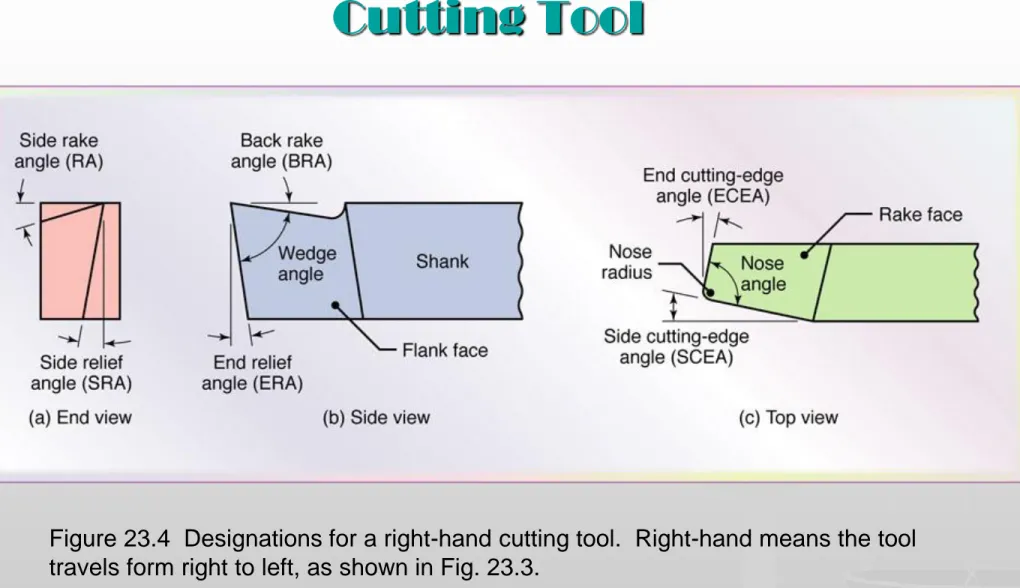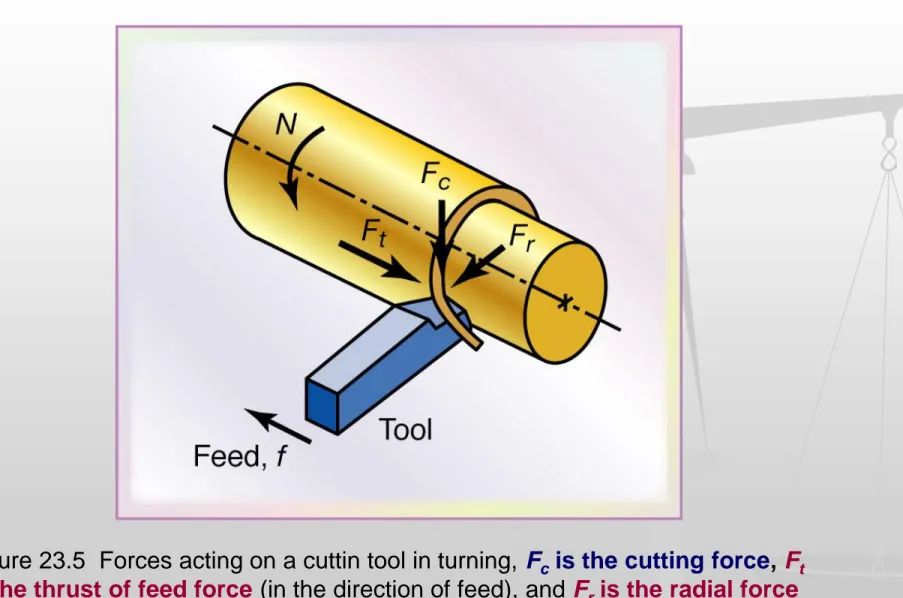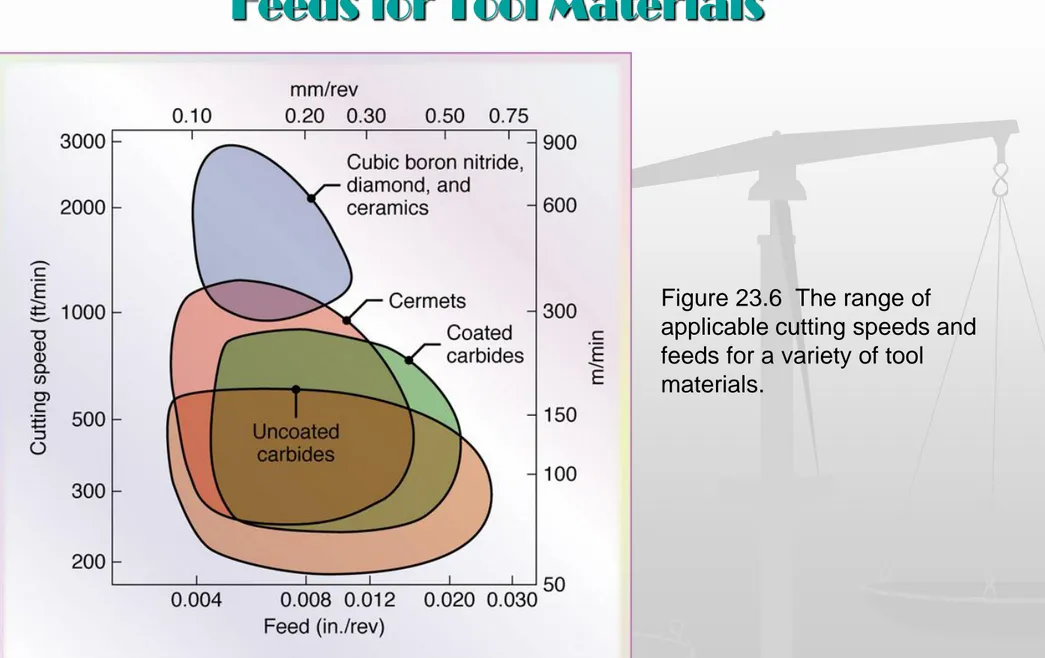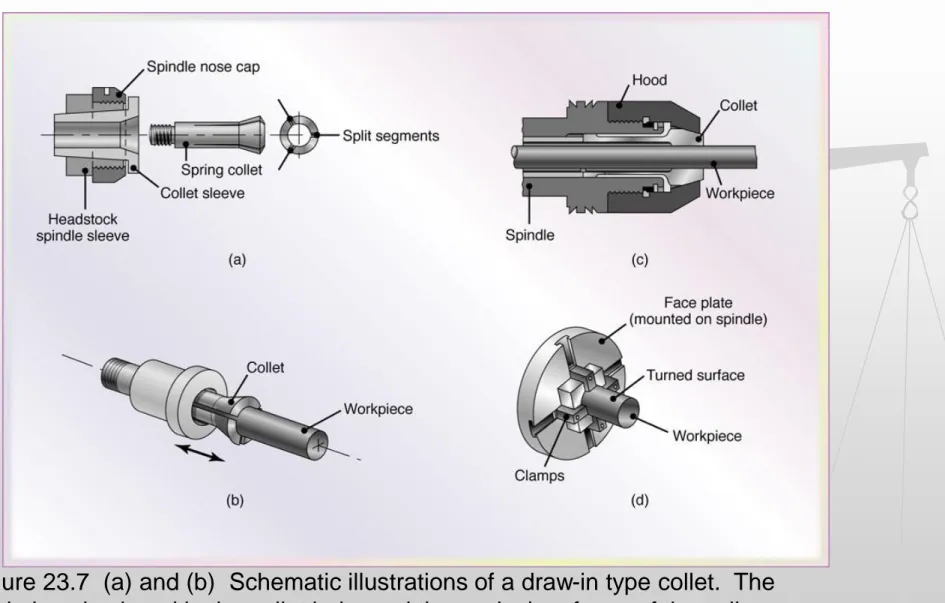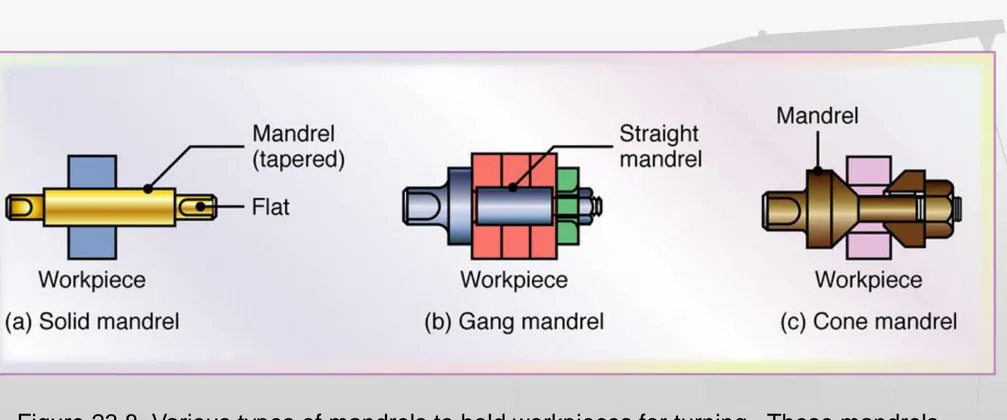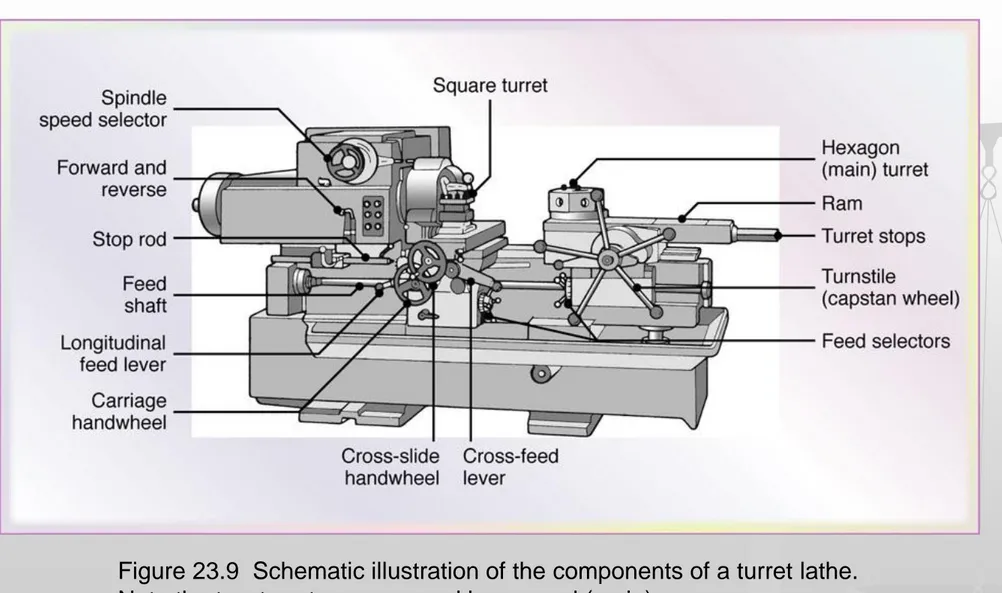Turning Process
Proses Manufaktur II
Sumber:
Mesin Bubut (
lathe
)
Mesin bubut merupakan
mesin serba guna
(
general purpose
machine
), karena
mampu mengerjakan
berbagai jenis
pekerjaan.
Bagian utama mesin
bubut adalah:
(1)
the
bed, (2) the headstock,
(3) the carriage, (4) the
tailstock, and (5) the
gearbox.
Engine Lathe (1600x12000) American
Salah satu cara u/ melihat dimensi benda kerja yg bisa
diproses di mesin bubut adalah dengan melihat
swing
dan
distance between center
dari mesin bubut.
Swing menunjukkan
diameter
maksimum benda kerja
yang bisa
Beberapa contoh mesin bubut (2)
Beberapa contoh mesin bubut (3)
Engine Lathe Part Descriptions
Spindle The spindle holds and drives the workpiece.
Cross Feed Handwheel
The cross feed handwheel is used to manually position and/or hand feed the compound rest in the X axis.
Carriage Handwheel
The carriage handwheel is used to manually position and/or hand feed the carriage in the longitudinal or Z axis.
Carriage The carriage houses the saddle, the cross slide, and the apron. The main function of the
carriage is to position the tool along the lathe bed.
Spindle
Clutch Lever This lever controls the spindle’s rotation and direction. Brake
This type of spindle brake uses the foot pedal. The foot pedal type of brake is found on many types of lathes. When the foot pedal is actuated, the spindle will stop regardless of the position of the spindle clutch lever.
Feed Rod The feed rod transmits power from the headstock to the carriage for feeding operations.
Lead Screw
The lead screw transmits power from the headstock to the carriage for screw thread cutting operations. On some lesser types of lathes the feed rod and the lead screw are used for both the feed and the screw cutting power transmission.
Rack The rack or gear rack, as it is sometimes referred to, links with the carriage handwheel to
make longitudinal movement of the carriage possible.
Bed Ways The bed ways align the components of the lathe. The bed is the back bone of the machine.
Figure 2 - Lathe Parts Descriptions
Headstock
The headstock houses the spindle and the components which drive the spindle and the feed gears.
Spindle Speed Selector
The spindle speed selector allows the operator to adjust the spindle speed of the machine.
Emergency Stop Button
The emergency stop button turns off the power to the machine.
Motor Start Button
The motor start button starts the electric drive motor for the machine. The motor start button does not control the spindle; however, it does supply the power.
Spindle Clutch and Brake Lever
This lever controls the spindle rotation. Through the use of this lever, the operator controls the spindle direction, spindle on, and spindle off. On some machines, when the spindle is turned off, a magnetic spindle brake is
applied. The other type of spindle brake is the foot pedal. The foot pedal type of brake is found on many other types of machines.
Lathe
Cutting
Operations
Figure 23.1 Miscellaneous cutting operations that can be performed on a lathe. Note that all parts are circular – a property known as axi-symmetry. The tools used, their shape, and the processing
parameters are described throughout this chapter.
Characteristics of Machining Processes and
Typical Dimensional Tolerances
Lathe
Figure 23.2 General view of a typical lathe, showing various components.
Turning Operation
Figure 23.3 Schematic illustration of the basic turning operation, showing depth-of-cut, d; feed, f; and spindle rotational speed, N in rev/min. Cutting speed is the surface speed of the workpiece at the tool tip.
Proses
Turning
: terminologi
Cutting speed
(kecepatan potong, m/menit):
kecepatan keliling di sisi potong pahat/permukaan
benda kerja.
Depth of cut
(kedalaman pemotongan, mm):
menunjukkan kedalaman potong pahat saat
proses pemotongan.
Feed
(gerak makan, mm/rev): seberapa besar
pahat memakan benda kerja saat benda kerja
berputar 1 putaran.
Designations for a Right-Hand
Cutting Tool
Figure 23.4 Designations for a right-hand cutting tool. Right-hand means the tool travels form right to left, as shown in Fig. 23.3.
General Recommendations for Tool
Angles in Turning
Summary
of Turning
Parameters
and
Forces Acting on a Cutting Tool in
Turning
Figure 23.5 Forces acting on a cuttin tool in turning, Fc is the cutting force, Ft
Range of Applicable Cutting Speeds and
Feeds for Tool Materials
Figure 23.6 The range of applicable cutting speeds and feeds for a variety of tool
General Recommendations for Cutting Fluids for
Machining
Typical Capacities and Maximum Workpiece
Dimensions for Machine Tools
Collets
Figure 23.7 (a) and (b) Schematic illustrations of a draw-in type collet. The workpiece is placed in the collet hole, and the conical surfaces of the collet are forced inwards by pulling it with a draw bar into the sleeve. (c) A push-out type collet. (d) Workholding of a workpiece on a face plate.
Mandrels to Hold Work-pieces for Turning
Figure 23.8 Various types of mandrels to hold workpieces for turning. These mandrels usually are mounted between centers on a lathe. Note that in (a), both the cylindrical and the end faces of the workpiece can be machined, whereas in (b) and (c), only the cylindrical surfaces can be machined.
Mandrel berfunggi u/ memegang b-kerja yang didalamnya berlubang (
hollow
work-piece
), agar b-kerja bisa diproses (
machining
) di mesin bubut.
Turret Lathe
Figure 23.9 Schematic illustration of the components of a turret lathe. Note the two turrets: square and hexagonal (main).
Numerical Control Lathe and Turret
Figure 23.10 (a) A computer numerical-control lathe. Note the two turrets on this machine. These machines have higher power and spindle speed than other lathes in order to take advantage of new cutting tools with enhanced properties. (b) A typical turret equipped with ten tools, some of which are powered.
Parts Made on CNC Lathes
Example 23.3: Machining of Complex
Shapes
Figure 23.12 Examples of more complex shapes that can be produced on a CNC lathe.
Typical
Production
Rates for
Various
Machining
Operations
Range of Surface
Roughness in
Machining
Processes
Figure 23.13 The range of surface roughnesses obtained in various machiningprocesses. Note the wide range within each group,
Range of
Dimensional
Tolerances in
Machining as a
Function of
Work-piece Size
Figure 23.14 Range ofdimensional tolerances obtained in various machining processes as a function of workpiece size. Note that there is an order os magnitude difference between small and large workpieces.
Cutting
Screw
Threads
Figure 23.15 (a) Cutting screw threads on a lathe with a single-point cutting tool. (b) Cutting screw threads with a single-point tool in several passes, normally utilized for large threads. The small arrows in the figures show the direction of the feed, and the broken lines show the position of the cutting tool as time progresses. Note that in radial cutting, the tool is fed directly into the workpiece. In flank cutting, the tool is fed inot the piece along the right face of the thread. In incremental cutting, the tool is first fed directly into the piece at the center of the thread, then at its sides, and finally into the root. (c) A typical coated-carbide insert in the process of cutting screw threads on a round shaft. (d) Cutting internal screw threads with a carbide insert. Source: (c): Courtesy of Iscar Metals Inc.
Chasers and Die for Thread Cutting
Figure 23.16 (a) Straight chasers for cutting threads on a lathe. (b) Circular chasers. (c) A solid threading die.
Parameter Turning
Z
w
adalah laju penghasilan geram,
f
adalah pemakanan (feed),
n
w
adalah putaran benda kerja (rpm),
d
m
diameter benda kerja setelah di machining,
a
p
adalah kedalaman pemakanan,
Parameter dan Perhitungan Dasar Proses
Pemesinan (Turning)
Waktu permesinan
Laju pembuangan
geram
Daya pemotongan
Daya motor
n
l
t
w w mf
d
a
n
a
Z
w
f
p w m
pZ
p
P
m
s w
mm eP
P
Parameter dan Perhitungan Dasar Proses
Pemesinan (Turning)
Daya pemotongan
Torsi
T
adalah torsi yang dibutuhkan,
ω
adalah kecepatan sudut =
2
N
di
mana
N
adalah putaran
spindle
(benda kerja),
F
cadalah gaya pemotongan (cutting
force),
